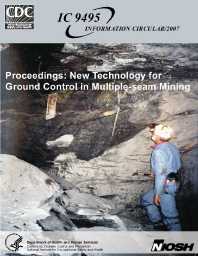Mining Publication: Multiple-Seam Mining in the United States: Design Based on Case Histories
Original creation date: May 2007
Multiple-seam interactions are a major ground control hazard in many U.S. underground coal mines. The two most common types are: Undermining, where stress concentrations caused by previous full extraction in an overlying seam is the main concern; and Overmining, where previous full extraction in an underlying seam can result in stress concentrations and rock damage from subsidence. The goal of the study described in this paper is to help identify the location and likely severity of these interactions. Mine planners can use this information to adjust the ground support, pillar design, or mine layout to minimize the hazard. In conducting the study, the National Institute for Occupational Safety and Health (NIOSH) relied mainly on an empirical approach. Empirical methods in ground control start with the concept that real-world mining experience, in the form of case histories, can provide valuable insight into the performance of very complex rock mechanics systems. In recent years, statistical analysis of large ground control case history databases has led to the development of methods for longwall pillar design, roof bolt selection, retreat mine pillar design, and design of rib support. Although fairly uncommon in mining, modern empirical research methods based on quantitative data analysis using statistics are the foundation of econometrics, epidemiology, and many other scientific disciplines.
Authors: C Mark, FE Chase, DM Pappas
Information Circular - May 2007
NIOSHTIC2 Number: 20032064
Proceedings: New Technology for Ground Control in Multiple-Seam Mining. Mark C; Tuchman RJ, eds., Pittsburgh, PA: U.S. Department of Health and Human Services, Public Health Service, Centers for Disease Control and Prevention, National Institute for Occupational Safety and Health, DHHS (NIOSH) Publication No. 2007-110, IC 9495, 2007 May; :15-27
See Also
- AMSS - Analysis of Multiple Seam Stability - 2.1.02
- Analysis of Multiple Seam Stability
- Calibration and Verification of Longwall Stress Models
- Modeling and Data Analysis of 50 to 5000 kHz Radio Wave Propagation in Coal Mines
- Multiple-Seam Mining in the United States: Background
- Preventing Equipment Related Injuries in Underground U.S. Coal Mines
- SPONCOM - A Computer Program for the Prediction of the Spontaneous Combustion Potential of an Underground Coal Mine
- Technology News 493 - Proceedings: New Technology for Coal Mine Roof Support
- Technology News 545 - NIOSH Updates Spontaneous Combustion Assessment Software
- Using the Coal Mine Roof Rating (CMRR) to Assess Roof Stability in U.S. Coal Mines
- Content source: National Institute for Occupational Safety and Health, Mining Program


 ShareCompartir
ShareCompartir
